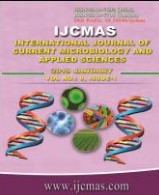


 National Academy of Agricultural Sciences (NAAS)
National Academy of Agricultural Sciences (NAAS)

|
PRINT ISSN : 2319-7692
Online ISSN : 2319-7706 Issues : 12 per year Publisher : Excellent Publishers Email : editorijcmas@gmail.com / submit@ijcmas.com Editor-in-chief: Dr.M.Prakash Index Copernicus ICV 2018: 95.39 NAAS RATING 2020: 5.38 |
The primary need of water resource development in any area depends on estimation of rainfall at different probabilities for efficient planning and design of irrigation and drainage systems, command area development, soil and water conservation programmes and the optimum utilization of water resources in various agricultural production systems. The annual maximum daily rainfall data of 18 years (1991 to 2008) was obtained from ARS, Mulde. It was analyzed for maximum one day and extended days (up to 6 day) rainfall for Mulde. Normal, Log Normal, Gumbel, Pearson Type-III and Log Pearson Type-III were used for extreme rainfall events. The relationships between annual maximum values of 1 day and D-days rainfall were found polynomial for Mulde (R2 = 0.9292 to 0.9615). Based on statistical test for goodness of fit, the Pearson Type-III distribution was found as the best fit for observed 2-day, 5-day and 6-day annual maximum rainfall. Log Normal distribution gives the best for the annual maximum one day and 3-day annual maximum rainfall data whereas, normal distribution gives the best for the annual maximum 4-day annual maximum rainfall data for Mulde. Maximum value of 1-day rainfall for Mulde ranges from 102.8 to 295.0 mm. Maximum value of 2-day rainfall ranges from 185.0 to 371.3 mm. Maximum value of 3-day rainfall ranges from 260.2 to 463.8 mm. Maximum value of 4-day rainfall ranges from 270.7 to 523.5 mm. Maximum value of 5-day rainfall ranges from 295.2 to 643.3 mm. Maximum value of 6-day rainfall ranges from 358.4 to 676.3 mm. An annual maximum rainfall of 167.03 mm in one day, 261.79 mm in two days, 335.24 mm in three days, 390.42 mm in four days, 450.22 mm in five days and 505.17 in six days was expected to occur at every two years. For recurrence interval of 100 years, the annual maximum rainfall expected in one day, two days, three days, four days, five days and six days was 368.31 mm, 487.73 mm, 588.90 mm, 700.17mm, 835.89 mm and 1068.35 mm, respectively. Consecutive day’s rainfall analysis provides valuable information for planning and management of runoff in watershed.
 |
 |
 |
 |
 |